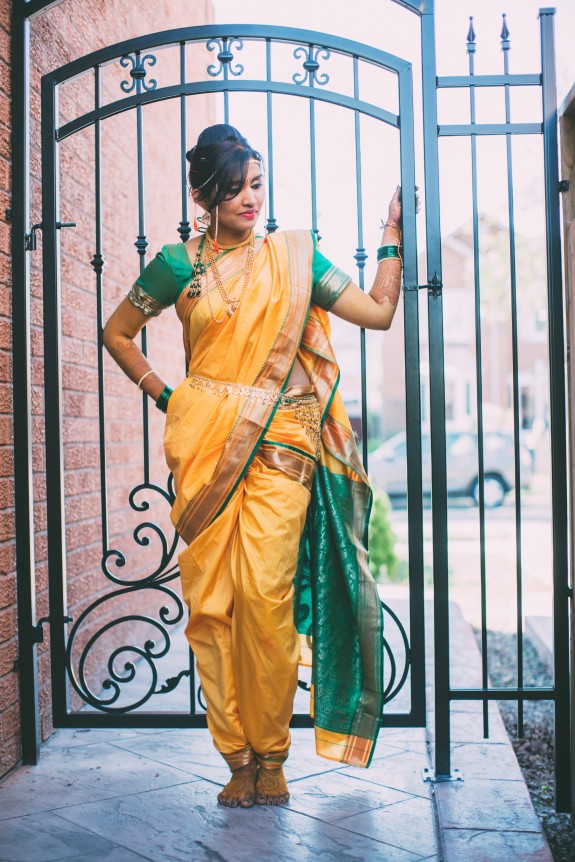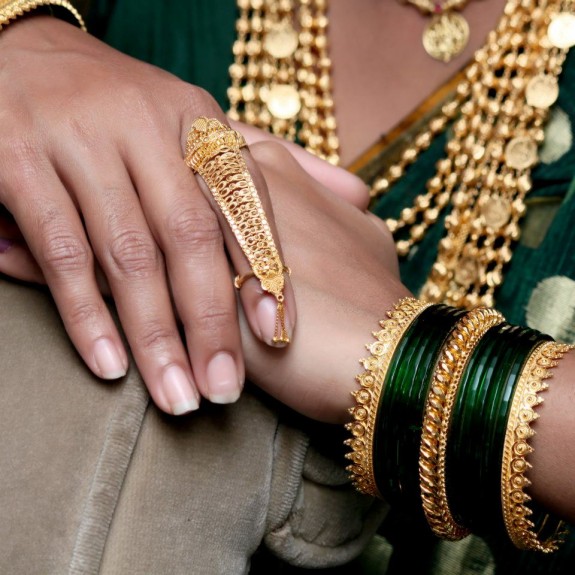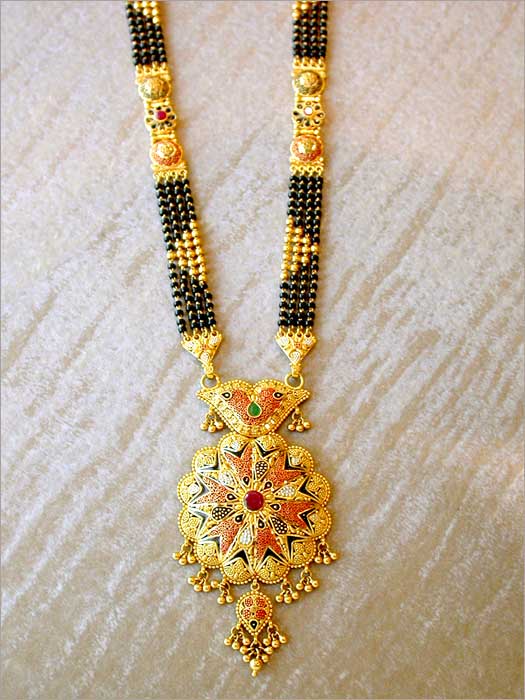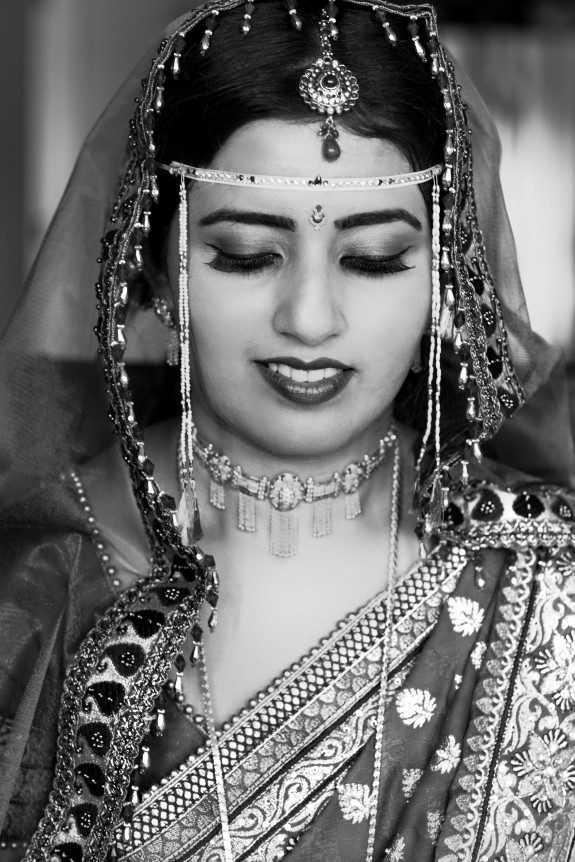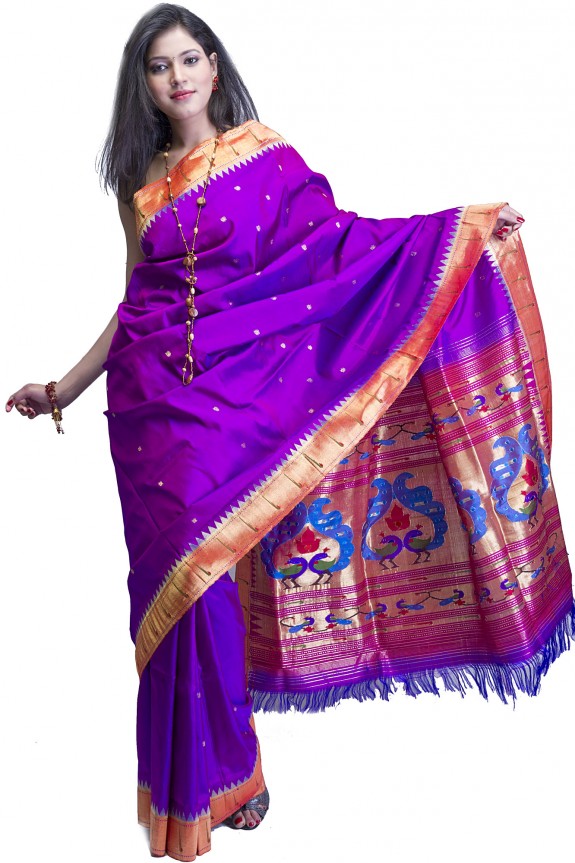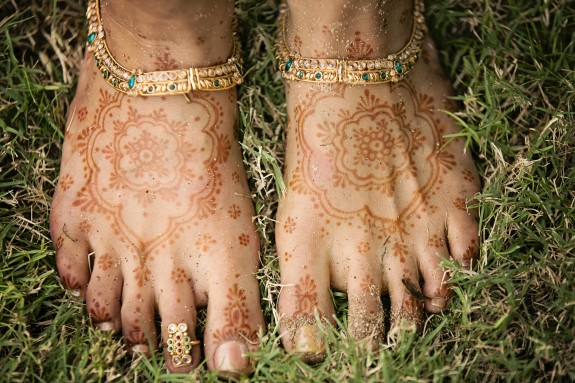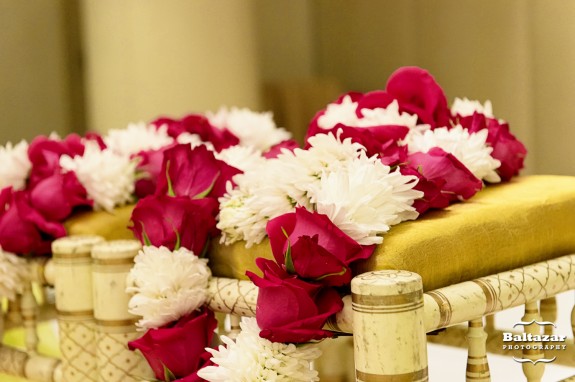CKP bridal attire is very similar to Maharashtrian bridal attire in general, aside from some specificities for certain ceremonies.
View the rest of the CKP Wedding Guide here:
Pre-Wedding/Engagement Rituals
Bridal Attire – You are here!
Haldi Ceremony
From Preeti and Peter’s Haldi Ceremony
For the messy haldi chadhavat, where turmeric paste is applied all over a bride’s skin to reveal a happy glow, a bride will often wear a simple salwar kameez. An outfit with pants is convenient for the ritual, since the bride will be fawned over and moved around by different female relatives as they apply paste all over her.
Since the outfit will get tainted yellow by the haldi, cotton is the preferred fabric for the salwar kameez. Cotton is cheap and easy to wash if necessary – a silk outfit, or any fancier attire with beads or expensive embroidery work, isn’t recommended for this ritual.
Wedding Rituals
A CKP bride will always wear a yellow or marigold, silk saree on the day of her wedding rituals. The saree is often of the Paithani version, a handmade silk saree made in the city of Paithan. These sarees are known for their shiny, monochrome design with thick borders. For a Maharashtrian wedding, the bride’s saree will feature green borders.
Some brides opt to wear the typical nauvari (9 yard) saree in yellow silk. These sarees are long enough to wrap around each leg like pants, creating a truly unique and relatively more comfortable look.
From Gunjan & Karan’s Maharashtrian Punjabi Wedding
A bride also wears particular jewelry that has been given to or handed down from female relatives. Green bangles, chooda, are worn on both hands in uneven numbers for good luck. The bangles tend to be inexpensive, made of plastic, and are more symbolic than decorative. They represent a new bride’s marital status, and they are worn by women even after the marriage ceremony to symbolize their place as female head of the household.
Gold jewelry is commonly adorned at CKP weddings, as it is at most Indian ceremonies. The gold jewelry is usually handed down from generation to generation, so the designs and patterns will be timeless classics from decades ago. You can read more about the styles of Maharashtrian jewelry here.
A mangalsutra is a necklace symbolizing marriage and worn by every married woman in India. In a CKP ceremony, the groom ties the mangalsutra – a necklace made of gold and black beads – around his new wife’s neck during the mangalsutra bandhan. She wears this necklace for the rest of her life, and it is one of the few ornaments of jewelry that will not be passed on to her daughter or other relatives.
Maharashtrian wedding attire features a unique headpiece, the mundavalya, made of flowers and string that both the bride and the groom wear during the wedding rituals. This headpiece can be as simple as golden string and some white flowers, or it can ornately decorated with pearls and jewels.
From Priyanka & Sandesh’s Maharashtrian Wedding
A CKP bride always ties her hair up during the marriage ceremony. It is commonly worn in a braid but can be adapted to buns or up-dos depending on the bride’s preference. With all the jewelry, headpieces, and garlands being worn throughout the ceremony, it’s important that a bride keeps her hair out of the way to avoid any mishaps!
Brides may opt to put some white jasmine flowers in their hair, attaching them to the bun.
Wedding Reception
A CKP wedding reception, while often held in a temple as well, is more informal than the wedding. Therefore, the bride can choose a different color scheme and hairstyle than the stricter restrictions of the wedding rituals allow.
Most brides still wear sarees to the reception, and these sarees are still often of the Paithani variety. Instead of gold as the singular color, brides usually opt for brighter, jewel-toned colors for the reception. Blues, greens, and purples are common choices for the shiny, silk reception saree.
Photo via exoticindiaart.com
Traditionally, the reception is held immediately following the wedding rituals, so a bride does not have time to change much of her hair and jewelry. She will usually leave her hair up in such a case; although nowadays, more brides hold their receptions at a later time and thus are able to change their outfits entirely. Most of the jewelry received through the wedding rituals (including the mangalsutra and the green bangles) are still worn during the reception, but the headpieces are removed.
Shoes and Other Accessories
Traditionally, a bride wears flat shoes to both the ceremony and the reception. Maharashtrians are simple people, and you won’t see heels at a conservative CKP ceremony. However, the shoes are only worn while entering the temple – once inside the religious venue, all footwear is removed. The bride, therefore, is barefoot for all of the wedding rituals.
From Suchitra & Victor’s Wedding
A bride is supposed to be gifted her wedding day shoes by her mama (mother’s brother) or a relative of similar importance. This gesture symbolizes her uncle’s love for her and his last well wishes to the bride before she becomes a married woman.
Both the bride and the groom put garlands of red roses and white flowers over each others’ heads once the ritual hymns have been said and the couple is officially married.
From Puja & Nicholas’ Fusion Wedding
A CKP bride may wear an ornate gold waistband around her hips, over her saree, but this is not a necessary accessory. Gold jewelry is often limited to necklaces, earrings, and bangles.


